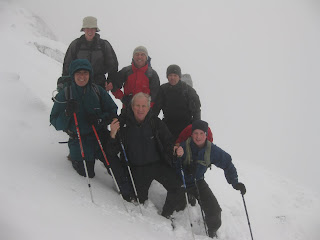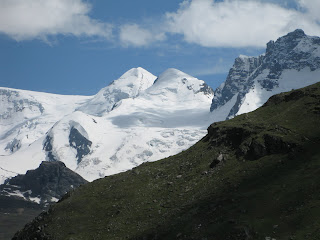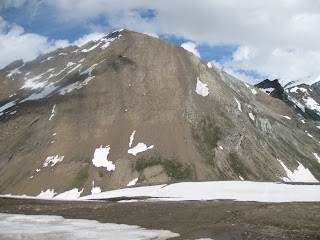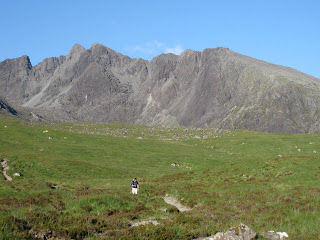‘Gloves’ Douglas was in town and was looking for some action. He had Weegie Girl tagging along with him. If there were hills to be climbed, she wanted in! So I found some hills for them and off we went to the far north-west of Scotland, to the ancient lands of Assynt and Coigach. The hills here are perfect two-thirds replicas of the mighty Torridon mountains further south and offer great hillwalking for less effort than your typical Munro. ‘Gloves’ arrived with his truckload of Red Bull determined to get up as many hills as possible and Weegie’s new boots looked like she meant business! Mind you, she normally does!
 Ben More Coigach
Ben More CoigachDay One called for an easy walk-in, good views and not too much distance – Ben More Coigach fitted the bill admirably. This complex hill presents a solid wall of Torridonian sandstone to those driving north up the Ullapool road. In reality, this wall is but one side of a reclining horseshoe and the mountain actually comprises several distinctive tops, foremost of which is Sgurr an Fhidhleir (705m; peak of the fiddler) which sticks out a blunt uncompromising nose across the loch-strewn landscape to the north. We parked at Blughasary and walked up a good track for 3 km before cutting across country to climb Ben More Coigach’s eastern top, Speicein Coinnich (717m). This entailed an interesting but successful river crossing which everyone achieved without mishap! Once on top the long ridge stretched out towards the sea and the Summer Isles glistened in the autumnal sunshine. The actual summit of Ben More Coigach (743m; big hill of Coigach) lies just north of the main ridge. The going is very easy and the traverse of the main ridge is full of interest. As you work your way down to the south-western top of Garbh Choireachan (733m), the ridge becomes a narrow scramble over sandstone pinnacles all of which can be by-passed on a good path on the northern side.

We returned the same way enjoying great views all-round, but particularly to the north where all of the following week’s hills could be seen stretching away towards the top of Scotland. This was Gloves’ first outing with trekking poles and it was only late in the day that we became aware of how like Brad Pitt they made him look. Brad Pitt playing Benjamin Button that is! Once he was shown how to extend them beyond the 3 feet length he had seemed happy with, all was well and he was able to walk quite upright! That said, his slow motion back-flip into a peat bog was executed with great aplomb! Some people are just so ostentatious and attention-seeking on the hill don’t you think?

The next day saw us tackling Scotland’s finest wee hill – Stac Pollaidh (612m; steep rock at the pool). This diminutive, but spectacularly attractive prominence is a crumbling ridge of sandstone surrounded by steep heather-covered scree slopes that give it a somewhat volcanic – and extremely photogenic - appearance from the east. Stac Pollaidh stands only a kilometre north of the twisting single-track road to Achiltibuie above Loch Lurgainn. An excellent path climbs and curves around the eastern side of the mountain and on to a saddle on the summit crest. Once on top, it’s just (did I say just?) a scramble along the ridge over, along and around a series of sandstone pinnacles until a final ‘difficult step’ suddenly throws down a challenge to those uncomfortable with slipping, falling and death! The small tower that now blocks the way looks worse than it is but caution is definitely advised even though the actual summit of the mountain now lies only a few metres beyond. Today, a ferocious wind persuaded us that retreat was the better part of discretion and we retired back along the ridge in no way feeling short-changed such was the entertainment value (and challenge) of the rest of the ridge.

Rather than return by the upward path, we picked up a continuation of the path that circles the whole hill thus allowing close scrutiny of the entire summit ridge from below. Stac Pollaidh offers a short day and is an ideal ‘stocking filler’ in between the bigger mountains in the area. It is always interesting and never palls no matter how many times you scramble along that crumbling pile of sandstone. Be quick though; devoid of its protective quartzite cap, the mountain’s sandstone is eroding rapidly and the elements are busy remodelling the pinnacles - they wont be there for ever!
 Cul Mor
Cul MorOur third hill day took us to the highest peak in Coigach, Cul Mor (849m; big back). From a lay-by below Knockan Crag 3km south of Elphin, a good stalkers path leads across country before climbing gradually up gently sloping quartzite strata to the subsidiary top of Meallan Diomhain. Here, the underlying rock changes to the familiar Torridonian sandstone and the summit cone of Cul Mor rises up directly in front of you. This can be tackled head on up steep mixed ground or, more usually, by crossing a small plateau and ascending Cul Mor’s north-eastern ridge. This provides not only a welcome path, but also good views across to Suilven – the pride of Assynt – and the impressive Coire Gorm (blue corrie) whose cavernous recesses drop vertically from the summit of the mountain. Take care approaching the summit as you once again encounter the quartzite in the form of tricky-sized boulders which demand care, particularly when wet. Once on top, however, no further difficulties should be encountered.
When climbing Cul Mor, do make the effort to walk the near-level kilometre along the mountain’s north-western ridge, Sron Garbh (rough nose), to a spectacular viewpoint over the Inverpolly National Nature Reserve. This vast empty area of ‘lochan and knockan’ landscape sits on underlying Lewisian Gneiss, some of the oldest rocks in the world at 1500-2500 million years of age, which surprisingly predates even the X-Factor! Those envisaging an exploration of this remote and watery land would be well advised to consider asking Santa to bring them a canoe for Christmas! The return to the car reverses your route back along Sron Garbh to a gravelly bealach between Cul Mor and its twin top Creag nan Calman (828m; crag of the dove). This can be climbed for completeness before descending eastwards back over Meallan Diomhain to the stalkers path.
Day 4 took us to the northern edge of Assynt and the wonderful 3-Corbett triptych that make up Quinag (milk pail). The complex Y-shaped collection of peaks and ridges looks particularly impressive when approaching from the north over the graceful curve of the Kylesku Bridge. However, the mountain is most accessible from an old quarry car park just below the summit of the watershed between Loch Assynt and Kylesku. This gives a relatively high start and a good stalkers path (currently undergoing well needed repairs) to follow initially before cutting across to pick up the easier slopes of the mountain’s southernmost peak and first Corbett, Spidean Coinich (764m; peak of the moss). This entertaining climb ascends over gently sloping strata of quartzite before dipping slightly followed by a final steep climb up to the summit. Today, this became a real battle against a remorseless buffeting wind and it was a real struggle to fight our way to the summit cairn which is perched right on the edge of the peak’s northern face. We were getting quite angry with the wind now so wasted no time in moving on in search of some shelter. As expected, once below the summit cone we entered a zone of calm which enabled us to stand upright and engage in conversation again, let alone walk properly! Regrettably, the thick cloud precluded our full enjoyment of the usually entertaining central spine of Quinag and we didn’t see anything until well down the mountain. A comfort break whilst ‘Gloves’ went off in search of a fully-flushing WC (or so it seemed given the time he took) ensured Weegie and I cold-soaked for just a bit too long. The resultant warm-up exercises in the form of a stylish hip-swerving dance thing (with impressive use of trekking poles for visual effect) was gleefully captured on video by ‘Gloves’. He will publish it on Facebook at his own peril.....!

For our last day, we decided to climb Cul Beag (769m; little back). This hill provides a good half-day with a short walk-in and modest climb whilst giving great views over the Coigach peaks. A larger than usual passing place 3km along the Achiltibuie road from Drumrunie provides a useful start for a fairly damp pathless trudge up a soggy corrie to the 500m level. Here, the going gets easier over a sandstone pavement until the upper mountain appears and a steep climb takes you up the final slopes to the summit. Swirling cloud and bright sunshine conspired to give us a great view of our brocken spectres – rainbow-coloured halos which encircle your own shadow and which are a familiar sight in such conditions. ‘Gloves’ was much impressed!






































 Beinn Damh
Beinn Damh
 The Horns of Alligin
The Horns of Alligin
 Beinn Eighe
Beinn Eighe
 Holding Tight on Am Fasarinen!
Holding Tight on Am Fasarinen!
